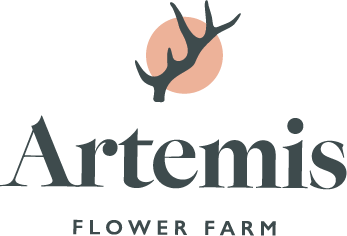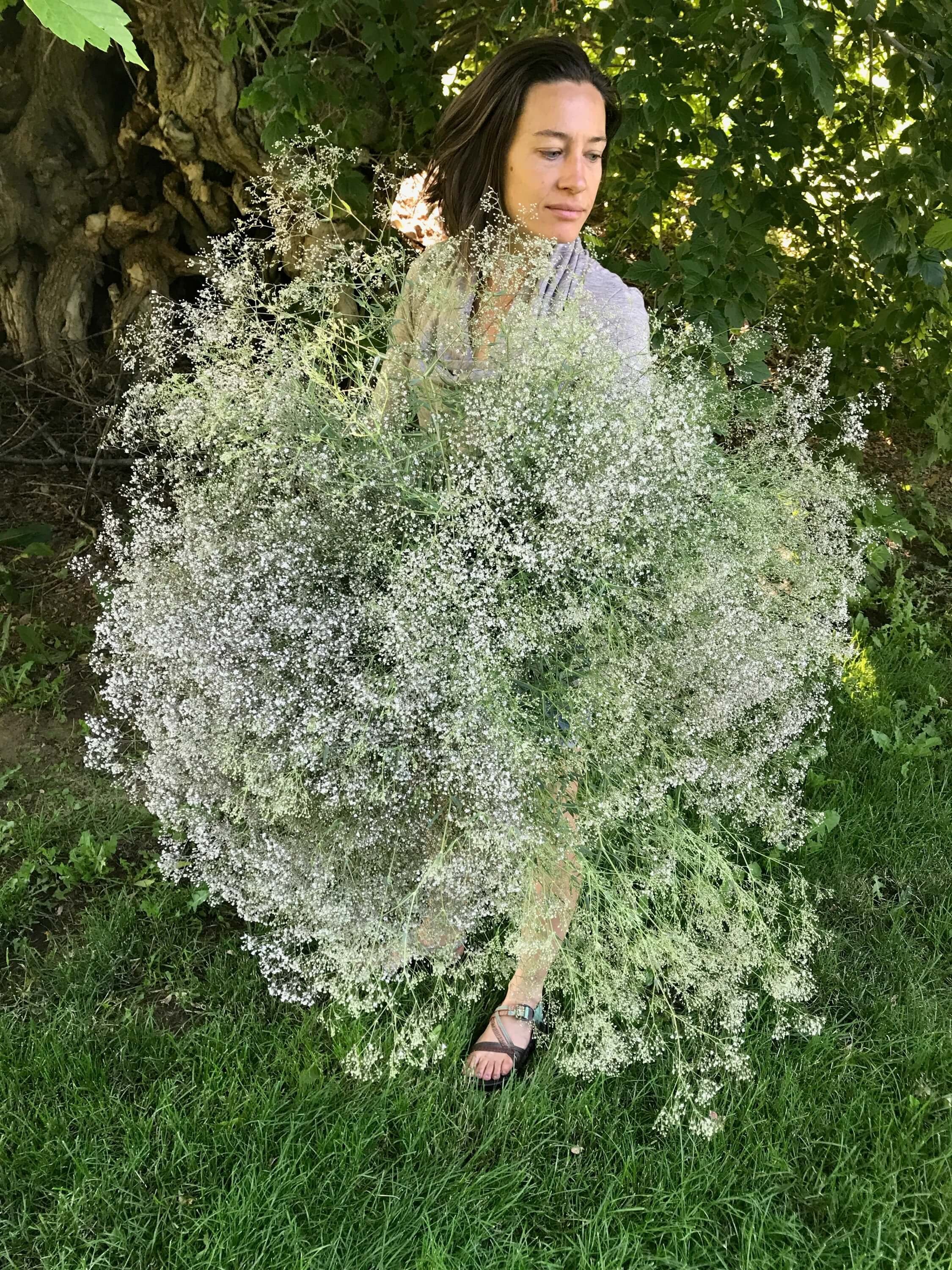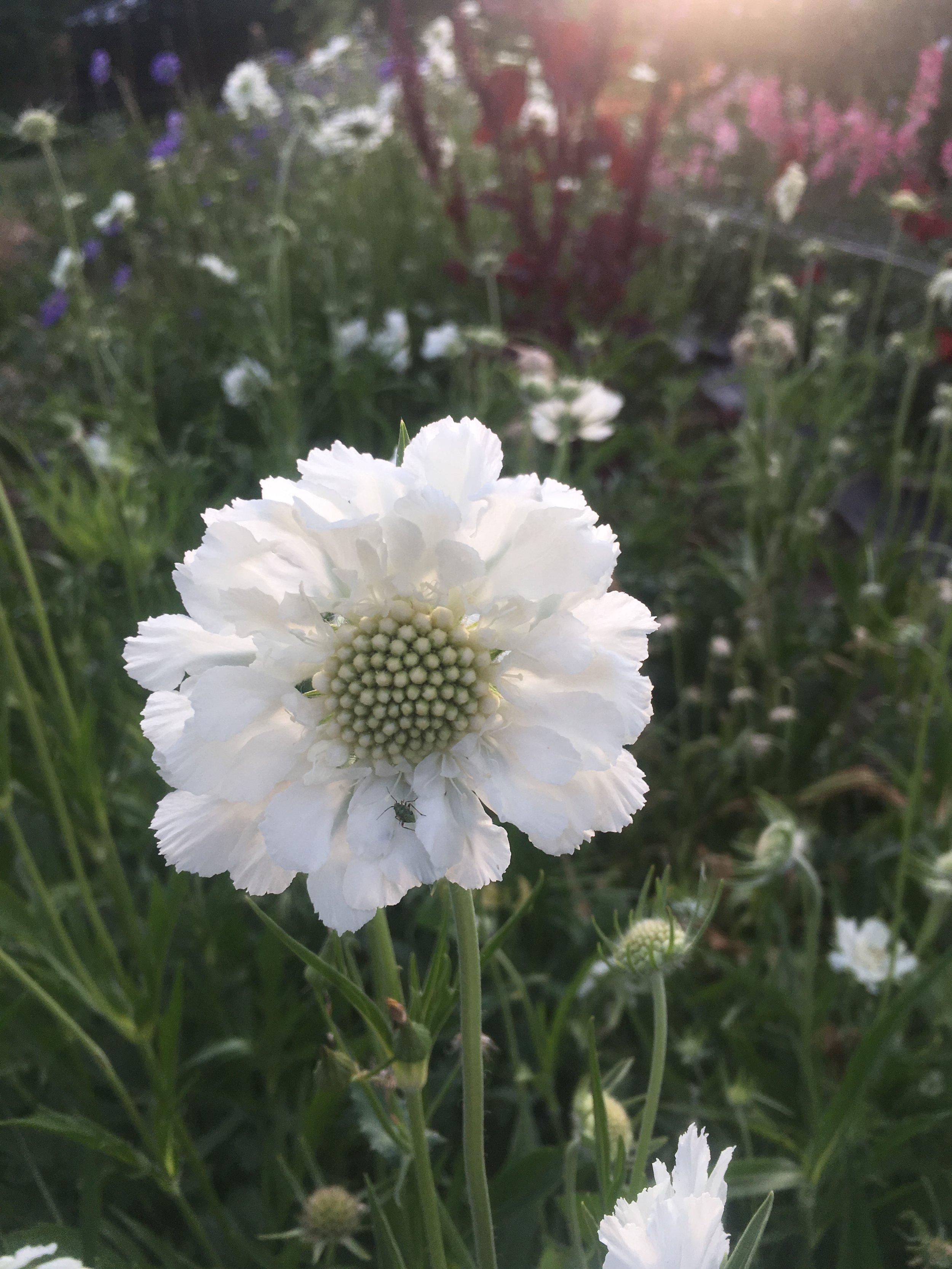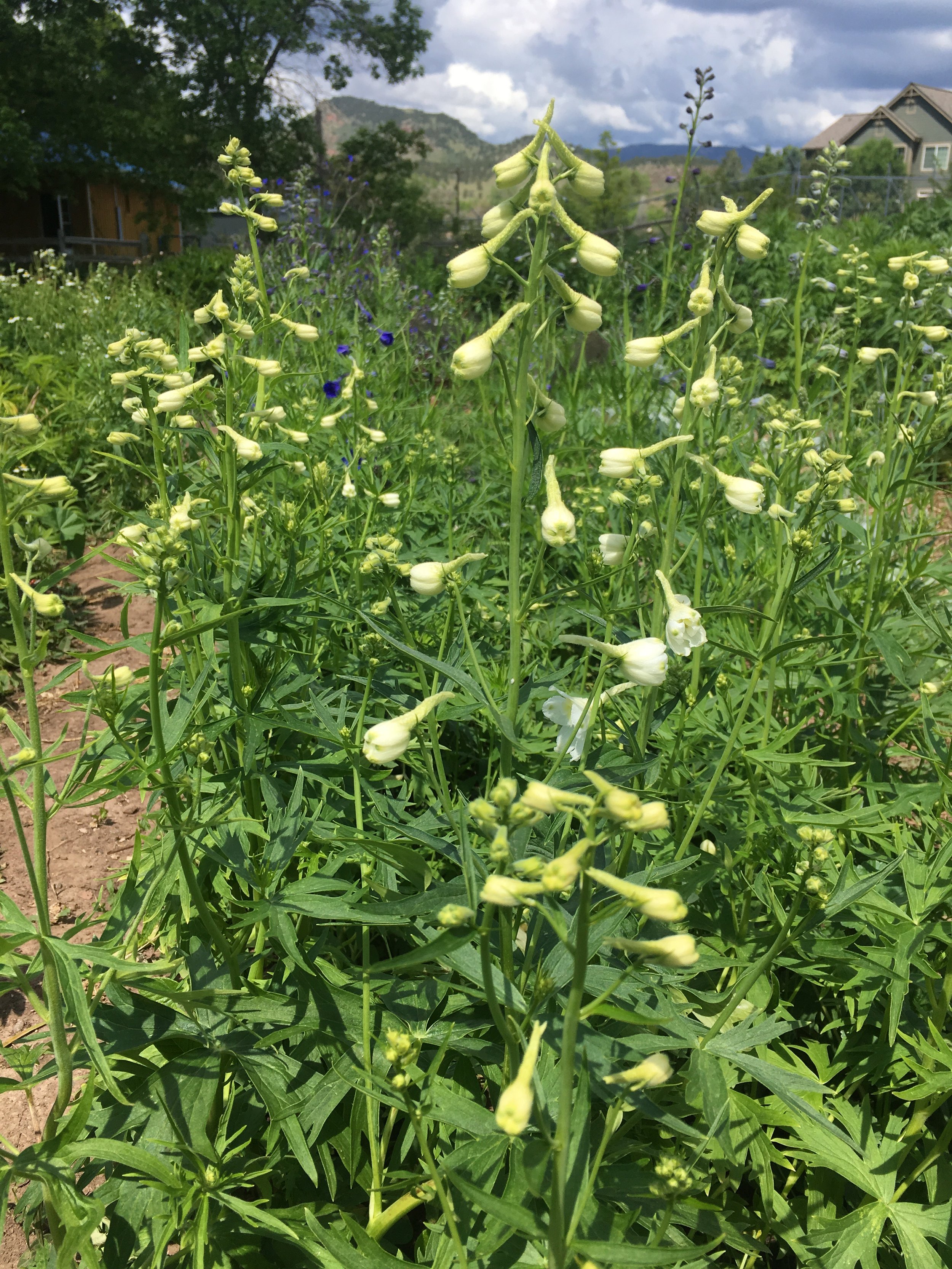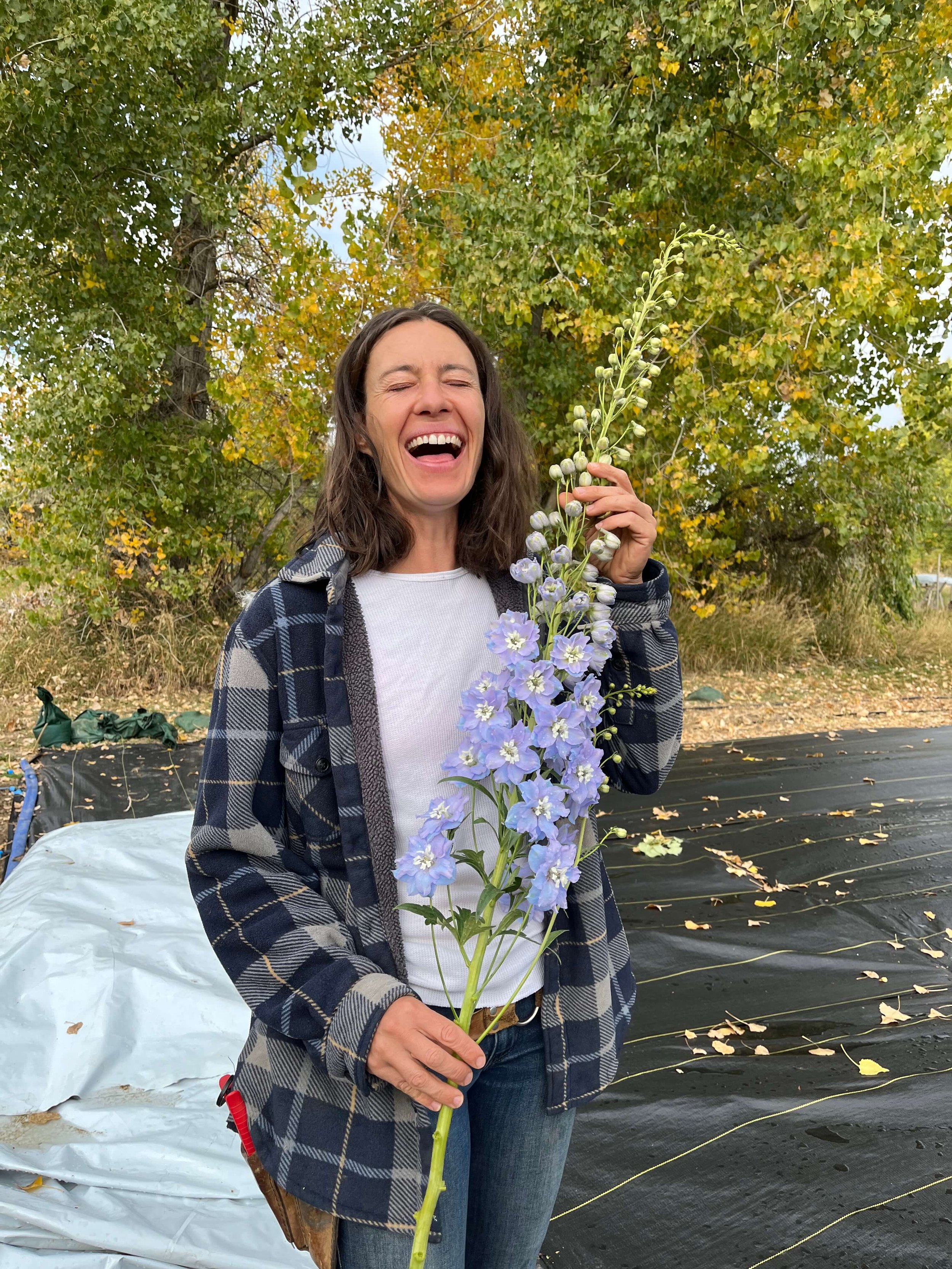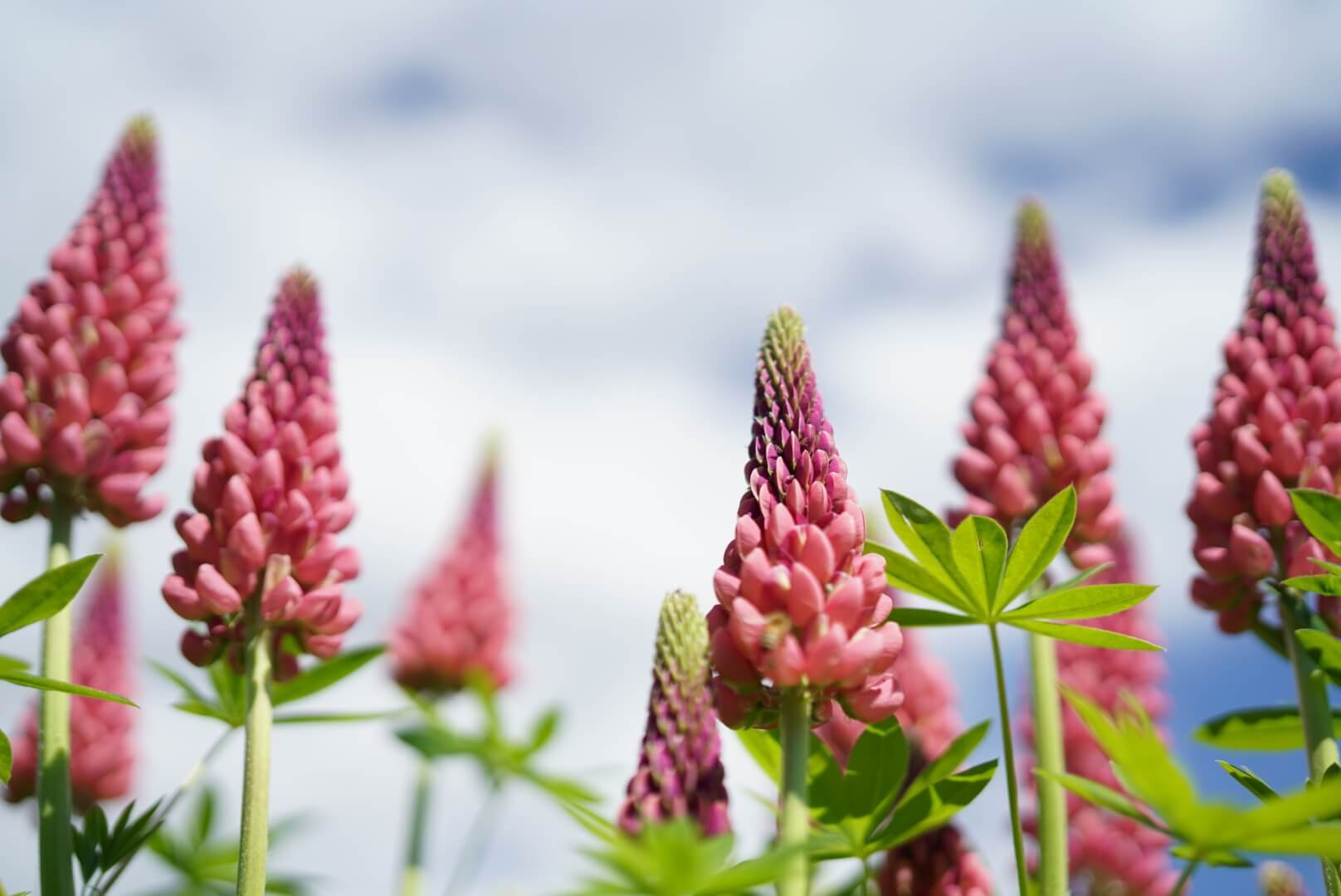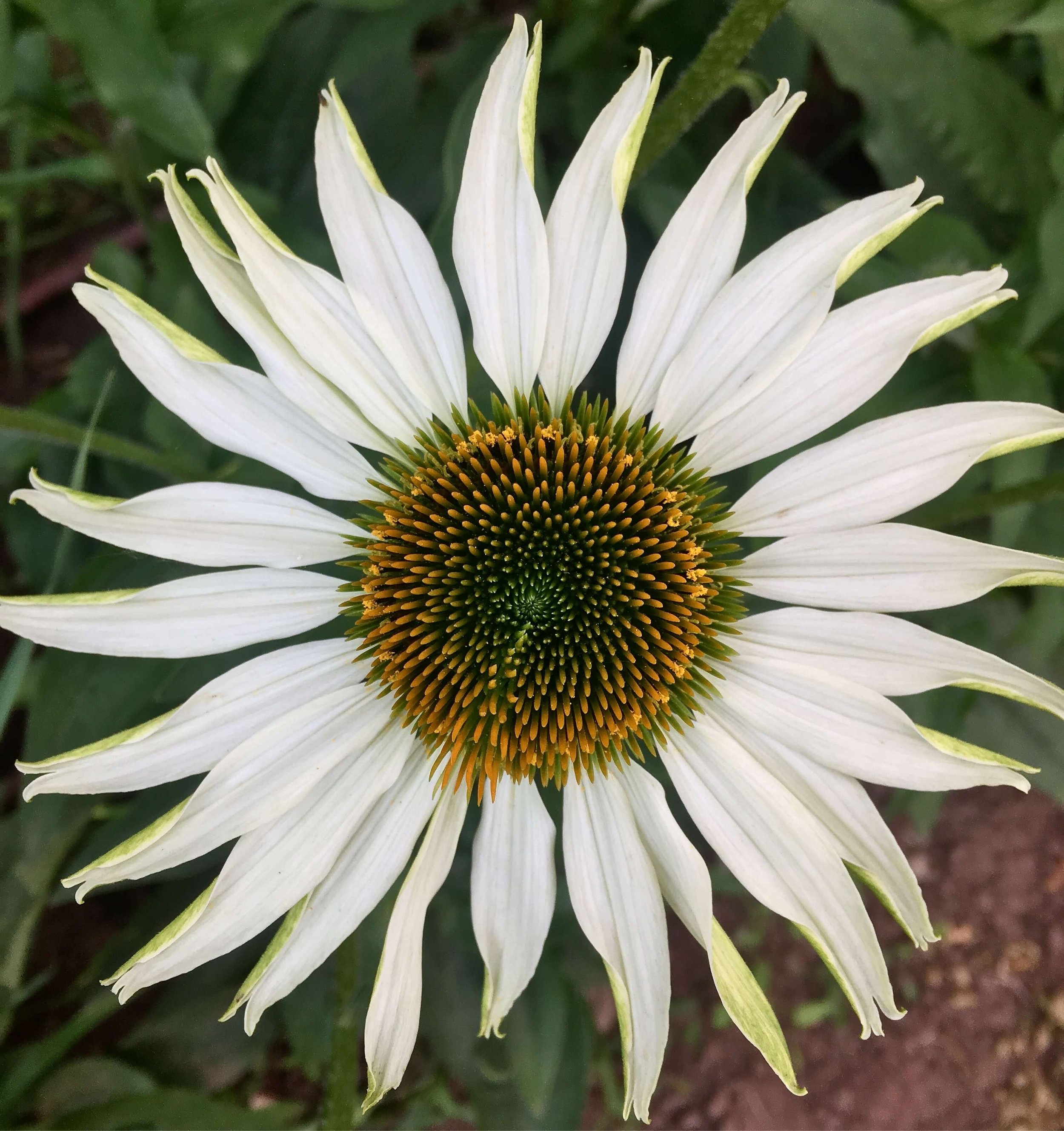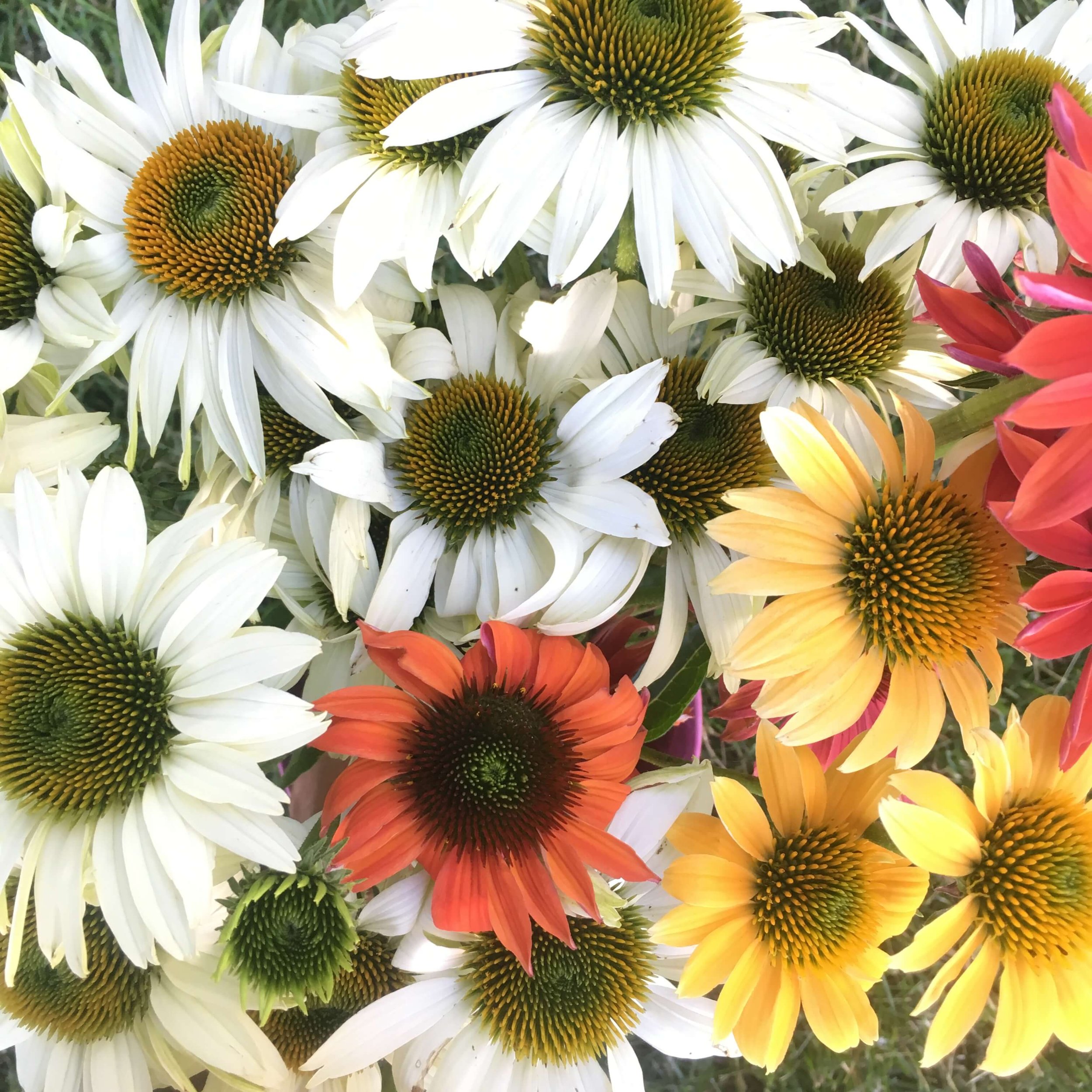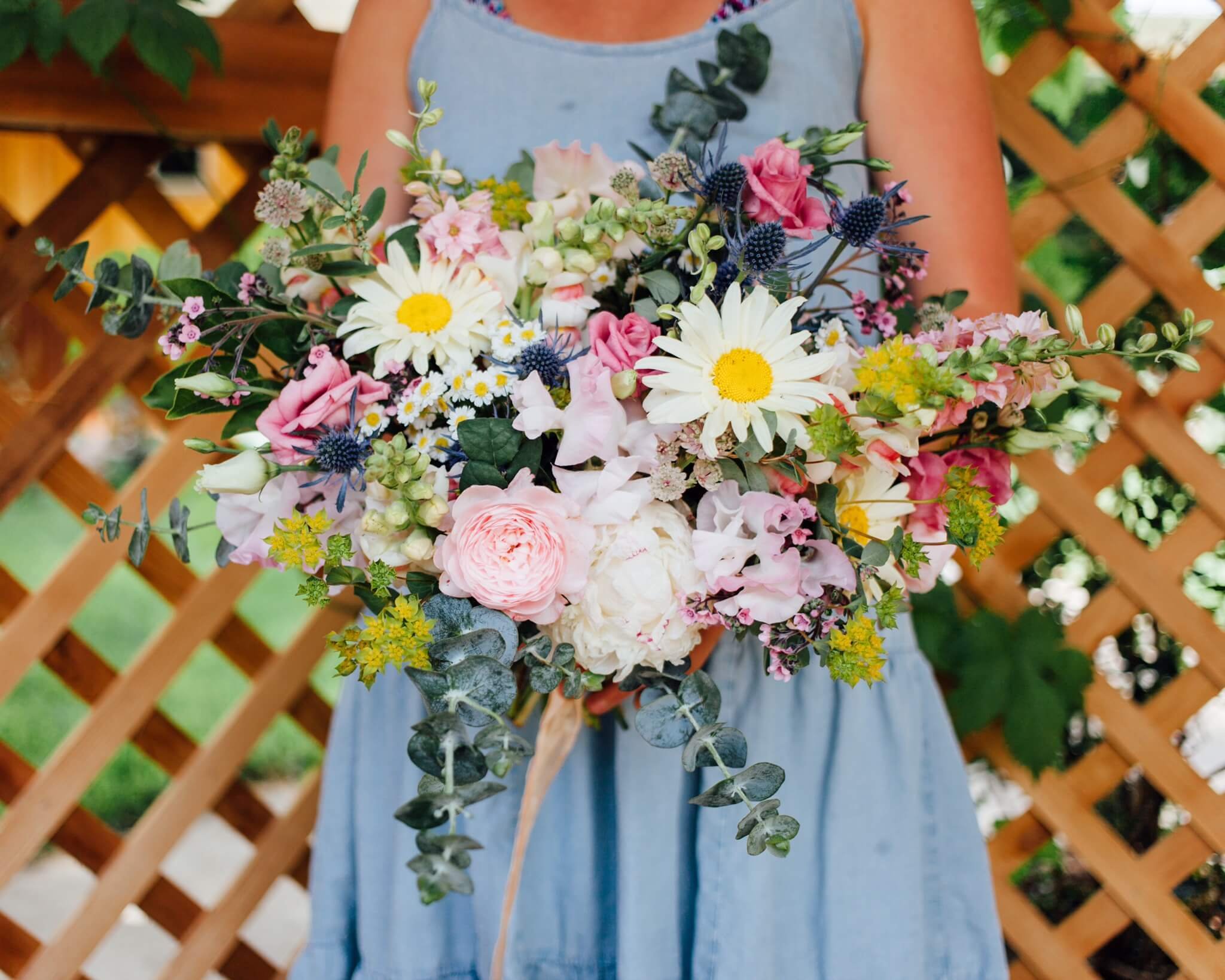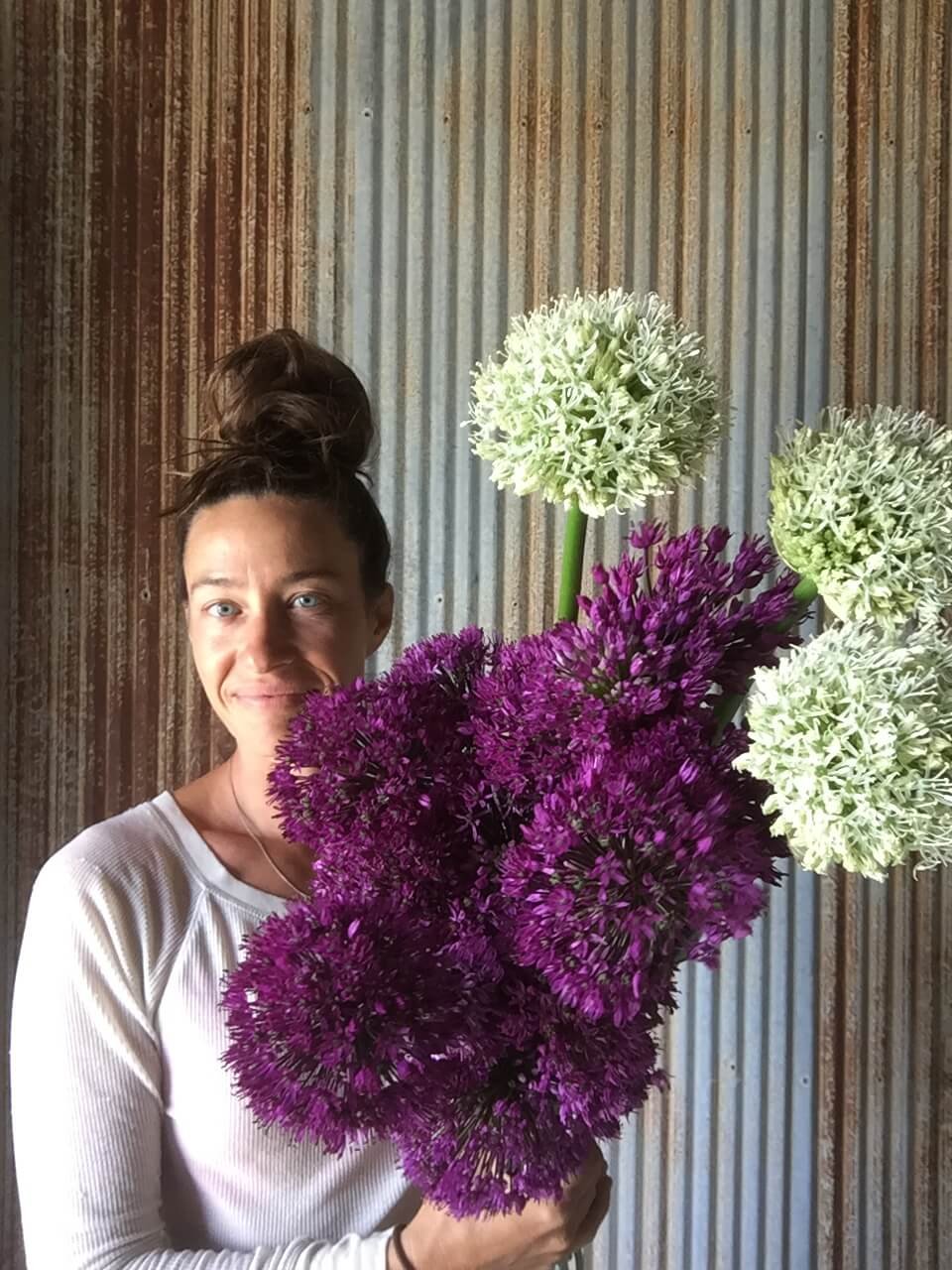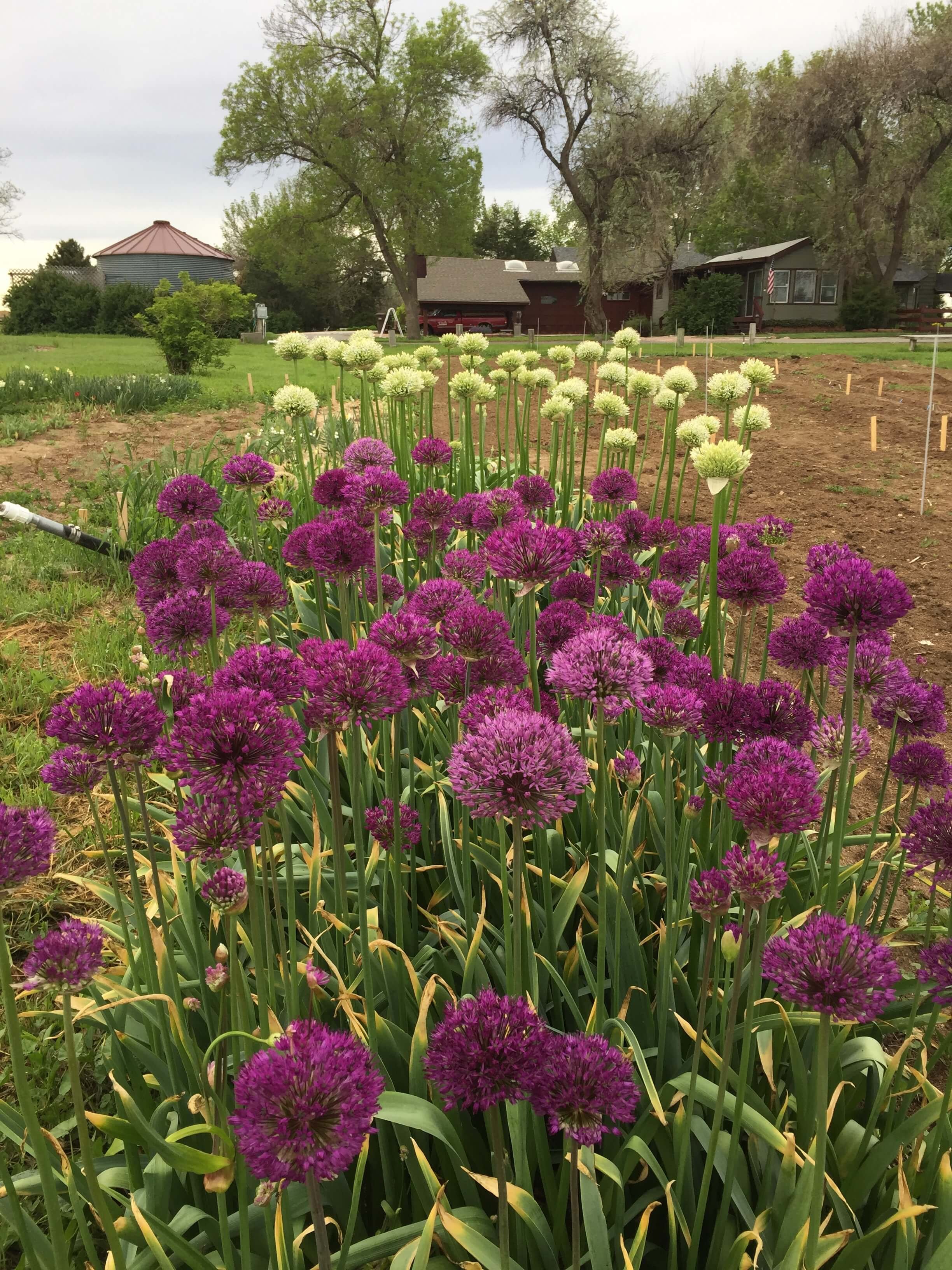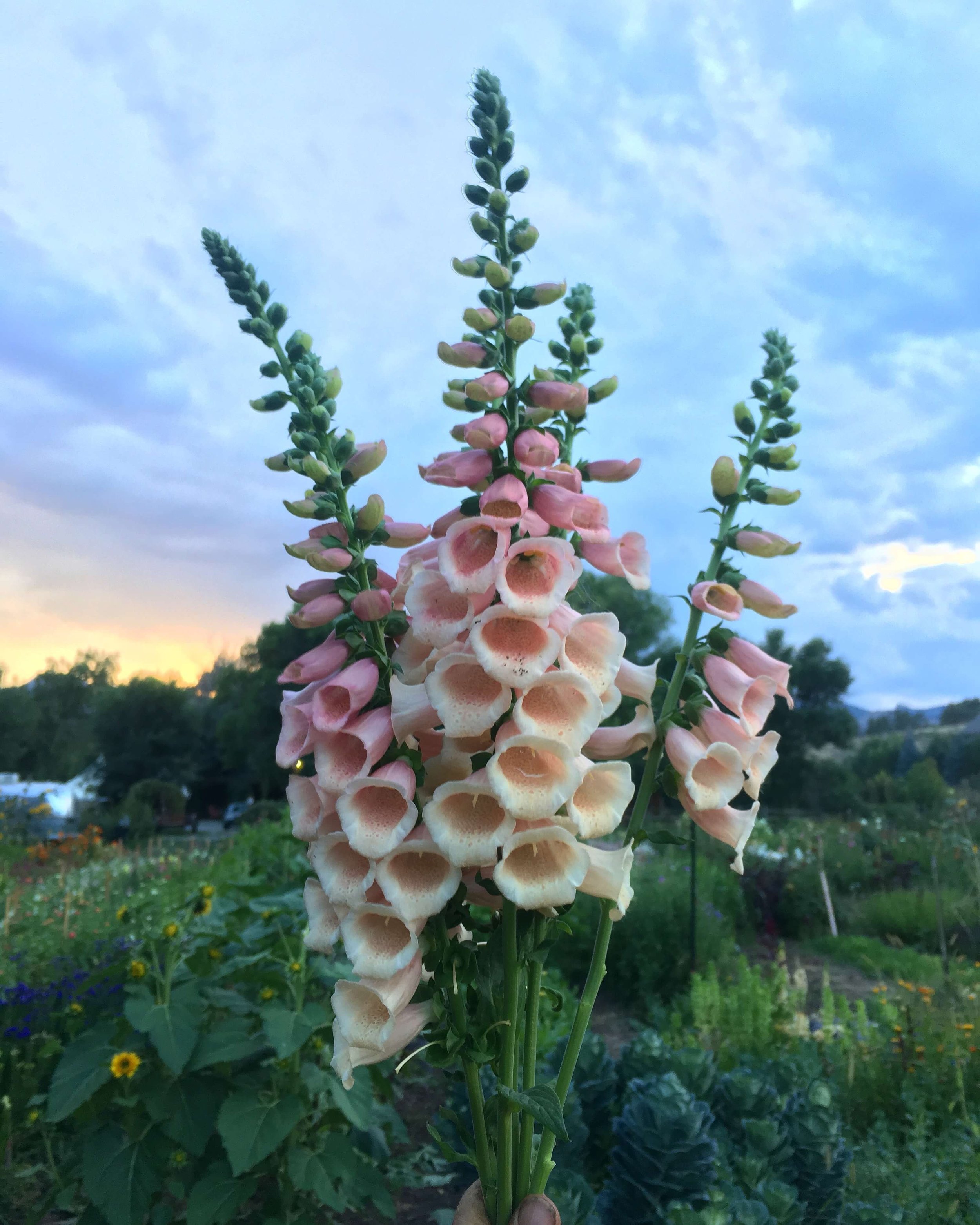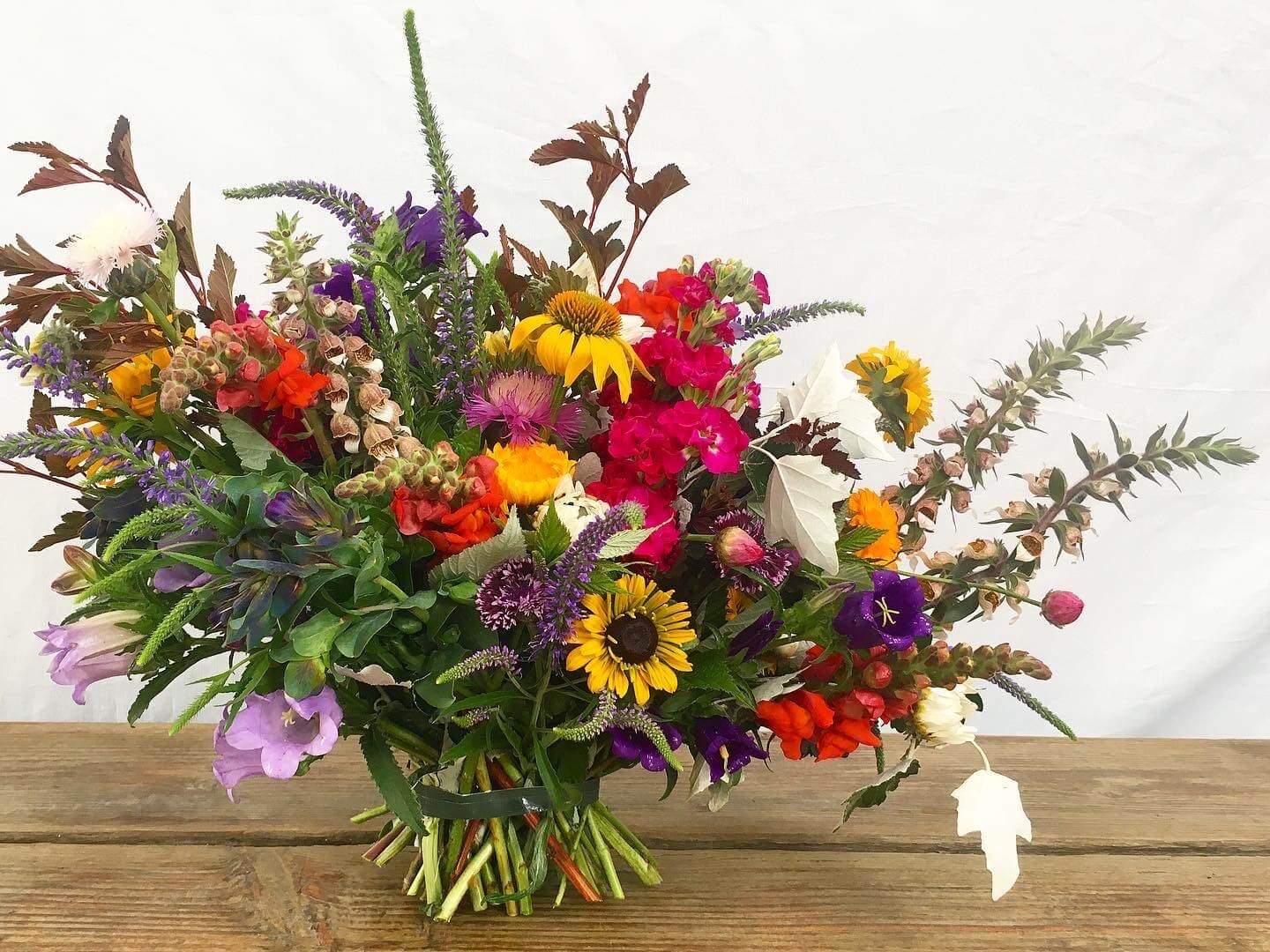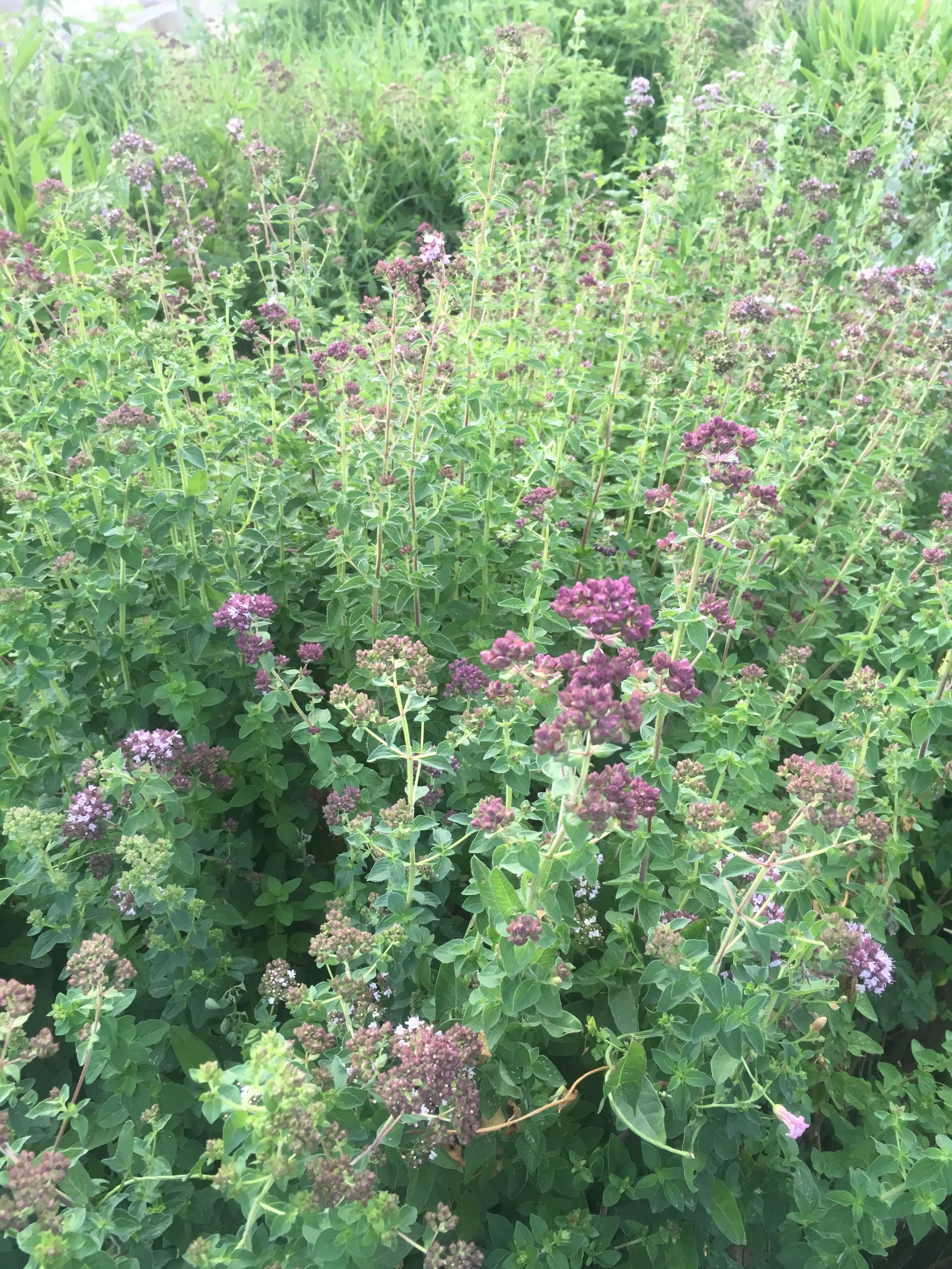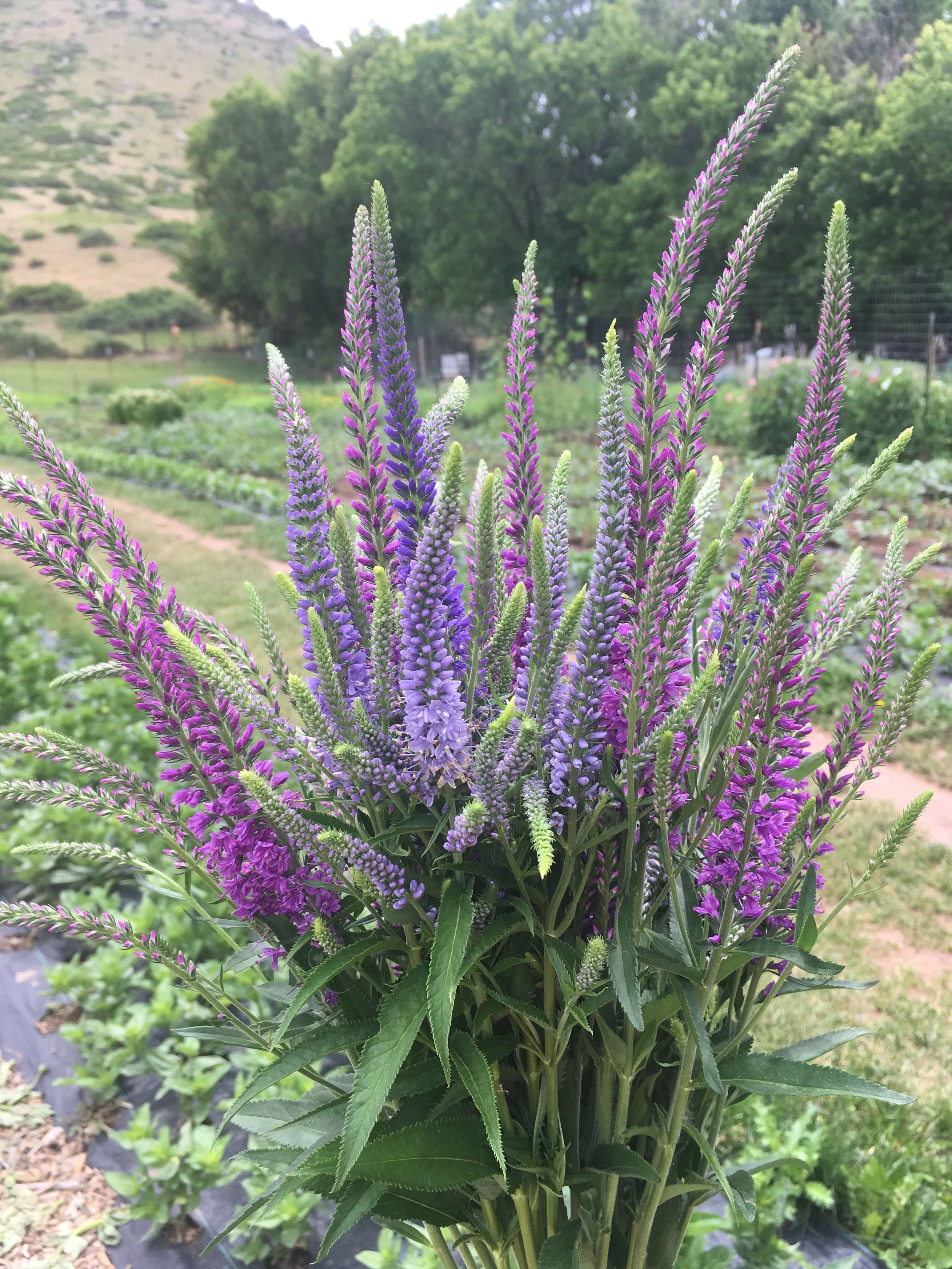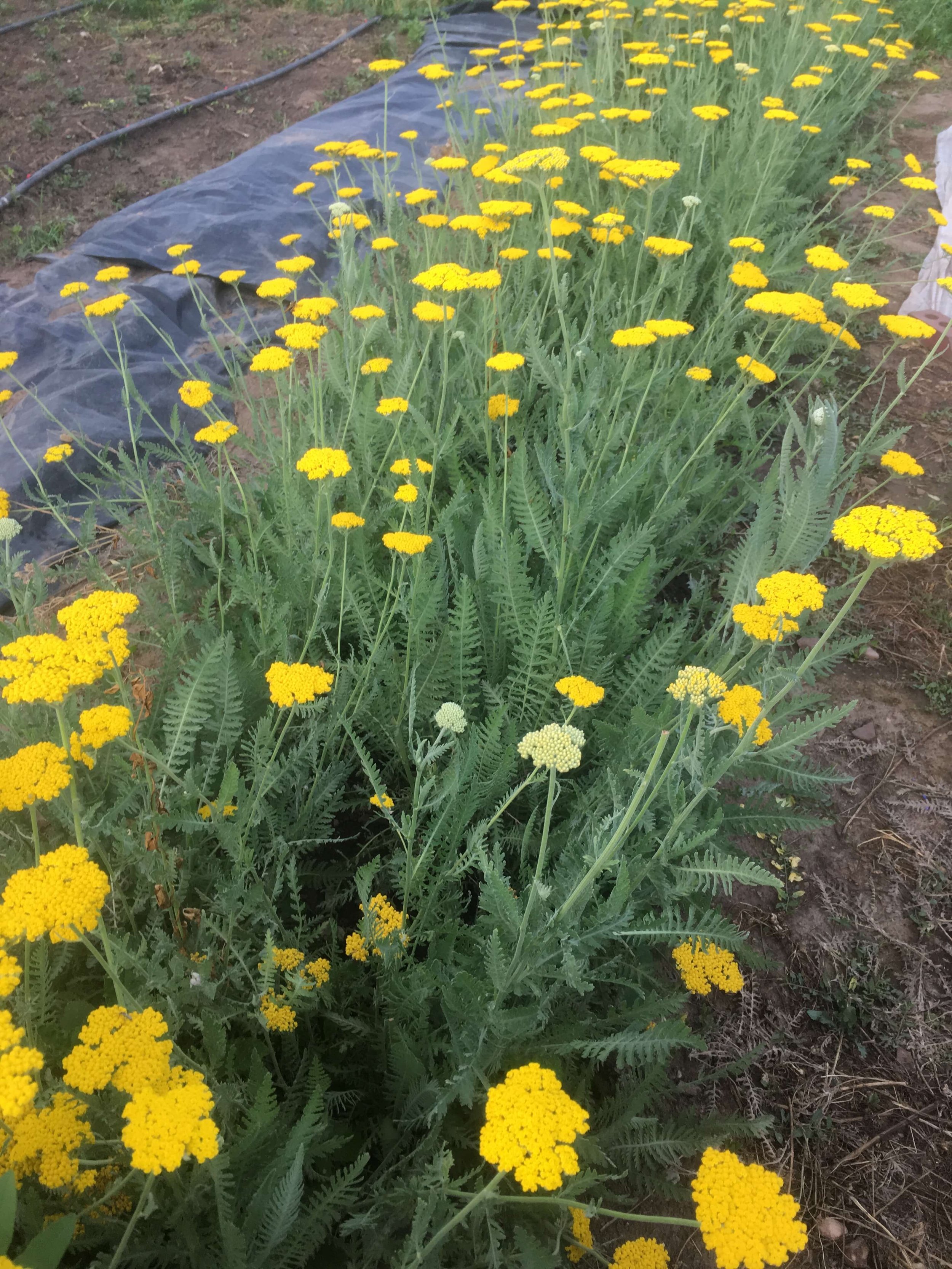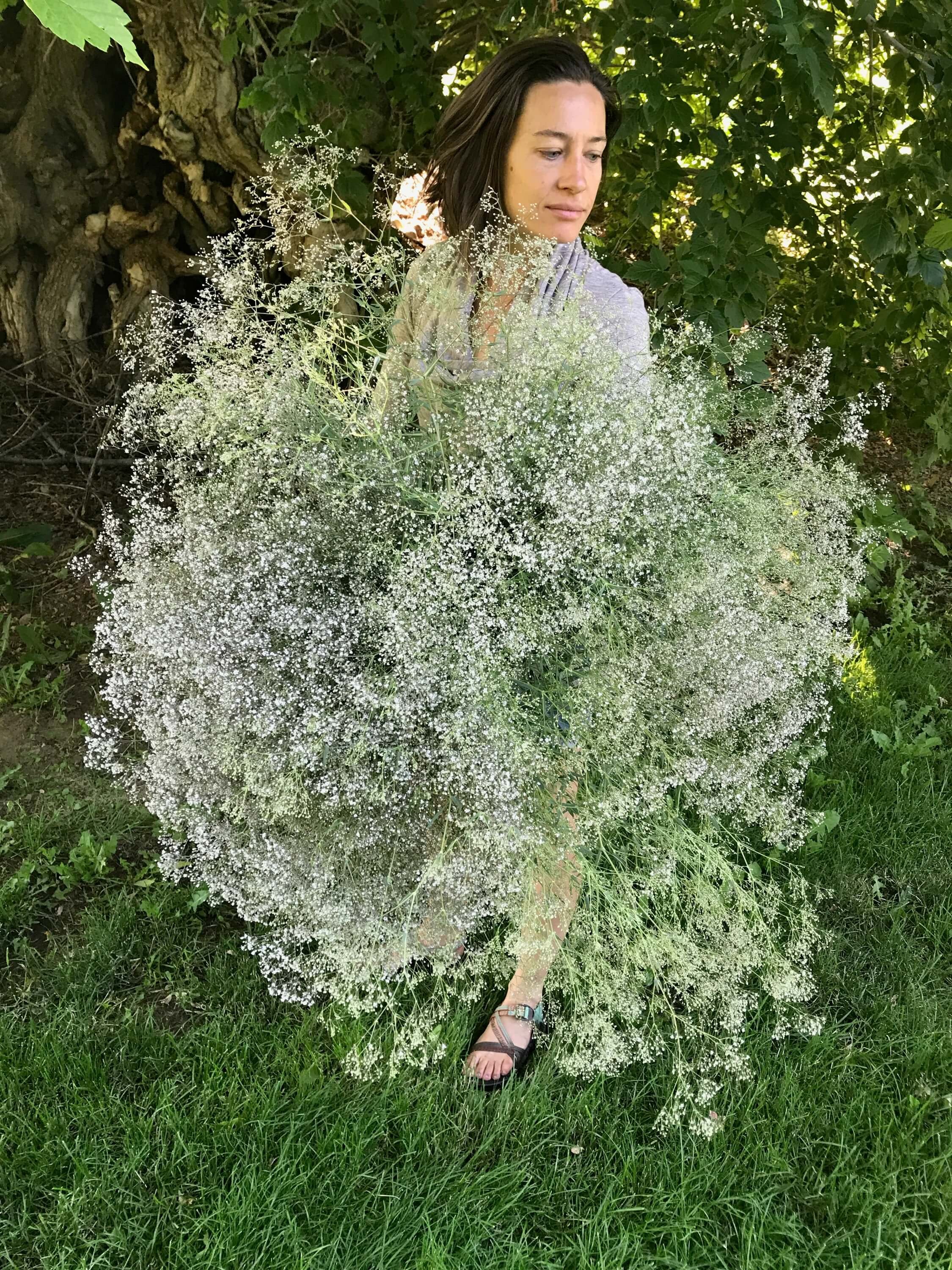Cheap & Easy Perennial Cut Flowers
Why Perennials?
Like many flower farmers, I started with easy annual cuts like zinnias, sunflowers, and cosmos. It was only after a few years that I felt confident enough to also be planting perennials, and that they could help me fill the flower gap between spring bulbs and summer annuals.
We can often be intimidated by perennials, because they can be difficult to start from seed, or impossible, and in that case are often very expensive as potted plants or plugs. We might also be concerned about “giving up” valuable annual flower space to perennials that may spread or be difficult to remove. But this blog is about all the awesome, hardy, productive perennial cut flowers you can grow easily from seed—and once you start getting those flowers from your easy perennials, you won’t be sorry you planted them instead of annuals! You won’t be breaking the bank to plant these, either, like you would with roses or peonies or hydrangeas. In addition, perennial plants provide year-round forage and shelter for birds, good-guy bugs, and support ecosystem health by keeping soils in place, sometimes photosynthesizing year-round, and providing windbreaks throughout your space.
The world of perennial cut flowers gives you a rich array of textures, colors, and bloom times that truly beefs up your cutting garden, whether in your home garden or on your flower farm. In addition, many of the species and varieties listed here are first-year flowering, meaning that they will bloom in midsummer or fall of their first year, though in subsequent years plants are usually much more robust. So you can plant perennials even if you have a shorter lease or land-tenure agreement! This year I sowed and planted thousands of perennials so that we’ll have plenty of unusual, sturdy cuts all season long.
This is quite a long post, so if you’re interested in something in particular, search through the page or use the links to the sections below. May your perennials live long & prosper!
Starting Perennial Seeds
Most perennial flower seeds, believe it or not, don’t need any special treatment and will germinate at normal temperatures in your home or greenhouse (60-70°). Some perennial flower seeds do need a little coaxing, but usually the task isn’t too onerous. A great resource for germination techniques is the German company Jelitto Perennial Seeds. Just use their catalog to look up the perennial you are considering starting, and refer to their table of germination codes under “sowing directions”. The easiest seeds to germinate are given a number (15) — be on the lookout for that number! Jelitto also sells preconditioned seeds (“Gold Nugget”) for difficult-to-germinate varieties, and these seeds will germinate within 2-4 weeks without any other treatment. Be aware that Jelitto does ship from overseas, so you’ll have some fees from Customs to deal with. GeoSeed sells a lot of perennial flower seeds, too, though to buy from them you’ll need a business tax ID.
Another seed source for great native perennials and seed-starting tips is Prairie Moon Nursery. I got one of my favorite perennials from them: prairie sage (Artemisia ludoviciana). For cold-germinators, they recommend simply placing the seeds in a bag of moist sand in the refrigerator for the specified time period (2-3 weeks usually does it). Some varieties will start sprouting in the sand; you can take them out and sow them on the surface of a pot or cell tray, covering with soil since they have already germinated. If the seeds have not germinated after 3 weeks, sow them on the soil surface in 60-70° temperatures, and you should see sprouts soon.
A couple of great investments for seed-starting are a heat mat and a thermostat, and some humidity domes for keeping the soil surface most (especially important in our dry Colorado climate). Be sure to remove seedlings from heat and from the humidity dome once they’ve germinated, and keep them between 60° and 70°F for best growth.
One last seed-starting strategy: if you think the seeds will be difficult, or you don’t know how old they are, and you don’t want to waste soil or time sowing them in containers, just put them in a moist paper towel, or mix with vermiculite, and wrap them in a beeswax cloth or plastic bag, providing some airflow. Put them at a good temperature and either provide light or don’t, according to the seed packet, and wait for germination. Make sure the paper towel or vermiculite stays moist. If the seeds begin to get mushy or moldy, you’ve lost that battle, but most likely, you’ll see sprouts within 10 days. Then sow the seeds on the surface of your container and cover them with a bit of soil or vermiculite.
Focal & Secondary Flowers
These flowers will elevate any bouquet or design you’re making, and wow your bucket-sales clients or your dinner guests. There’s nothing like a tall, charismatic delphinium spike to make everyone in the room swoon. They can also be lifesavers when you are sick of planting and harvesting annuals, appearing with no effort on your part and just generally being delightful.
Scabiosa aka Pincushion Flower (Scabiosa caucasica)
This beautiful short-lived perennial begins producing its first year from seed! They are easy to start in seed trays or with the paper towel method. The classic variety is the ‘Fama’ Series, with both a white and a deep blue/purple. The ‘Perfecta’ Series and ‘House’s Hybrids’ are other fantastic options with variations on blues and purples. They germinate well and produce big beefy plants with strong, thick stems, throwing flowers from May through frost, and will make you love scabiosa again if you are tired of cutting the wimpy stems of their annual cousins, S. atropurpurea. Their second year is particularly floriferous, and they can produce for up to 5 years if given enough space, but 2-3 years is more likely. Space at 18”x18” for best results (they get big!). Florists love these because they are long-lasting and make a big impression. Easy peasy lemon squeezy.
‘Fama White’
‘Fama Blue’
Delphinium (Delphinium cultorum, D. hybrida, D. belladonna)
Is there anything better than the stately height, true blue colors, and intricate floret formations of delphinium? They add so much drama to arrangements and can really make you feel like an artist when designing. These guys like a cold treatment of 2-4 weeks in the fridge with moist sand or vermiculite before they will germinate. After their chilling period, sow them as usual. You can also take cuttings of existing plants! Take 3-4” cuttings of new shoots poking up from the base of the plant in the spring, place them in a potting mix, and use a humidity dome over them until they root (in 3-4 weeks). Plant your seedlings out at 12 x 12” or 12 x 18”, and as stalks begin to form, be sure to add netting or other staking for support, as they will often collapse in high winds, or their cups will fill with water in rainstorms and become top-heavy.
I love the classic D. cultorum ‘Giant Pacific’ varieties, as well as the less dense D. belladonna varieties, like ‘Cliveden Beauty’, ‘Casablanca’, and ‘Oriental Blue’.
These are the less-dense spikes of the belladonna species coming into flower.
Practicing my air guitar on this delph stem
Unicorn colors
Lupine (Lupinus polyphyllus)
Another fantastic native flower, lupines are gorgeous and unusual in flower arrangements, or on their own in a casual vase. My favorite varieties are the classic ‘Russell Hybrids’, ‘Tutti Frutti Mix’, ‘New Millennium Mix’, and ‘Woodfield Hybrids’. You can have pretty much any color except true blue.
They are not vigorous germinators, but if you scarify the seeds by rubbing them on sandpaper, they will take on water faster and germinate more evenly. They should be covered in soil as darkness helps germination.
One caution with lupines: they can be easy prey for aphids, who will invade every crevice of every floret. Make sure they are very healthy plants and consider planting beneficials like marigolds, sweet alyssum, and others nearby. According to this blog from West Coast Seeds, only a few species of parasitoid wasps feed on the particular aphid that preys on lupines. There are a few other tips and suggestions for the issue in that blog post.
Sky-high
Early spring bouquet with lupines
Daffodils (Narcissus spp.)
Daffs are such an easy, no-fuss bulb that there’s just no reason you shouldn’t have a row somewhere in the garden. They’re a bit more expensive than tulips, but they will bloom and multiply for 3-5 years, after which they can be dug up and divided for more blooms or reinvigoration. They need to be planted deeply (8”), but it’s a one-time task. Mulching with leaves or wood chips will help the soil retain water and give daffodils the very moist feet they like. Plant in the fall, and for the longest production period, leave about 6” of space between each bulb.
There are an insane number of daffodil varieties. I’m partial to the doubles and multi-flowering ones.
‘White Lion’
They were a little short that year, but most should be fine!
Echinacea (Echinacea purpurea)
One of my all-time favorite perennials, both for its toughness and beauty, echinacea offers mesmerizing flowers throughout the season, many different warm colors, and the added value of dried cones for fall arrangements. It’s native to the prairies of North America and well adapted to dry soils. Some of my favorite varieties are the exceptional ‘Cheyenne Spirit’, as well as ‘Mellow Yellows’, ‘Magnus’, and ‘Primadonna White’. While I haven’t grown ‘Green Twister’, it’s a very tempting novelty!
I’ve never had much trouble germinating echinacea. They need a pretty warm temperature, about 70-72°. One trap you can fall into is making your soil too moist and waterlogging the plants, because they do sometimes take 3 weeks to germinate. Just let them be, and keep them fairly moist but not wet. Really easy, and they should be part of your garden for native insect and microbe habitat, even if you’re not cutting them. I planted mine at 12 x 12”, to create a good leaf canopy and for long stems.
Echinacea ‘Primadonna White’
Echinacea ‘Cheyenne Spirit’
Shasta Daisy (Leucanthemum x superbum)
This darling daisy is exceptionally easy to germinate – I had WAAAY too many plants this year after sowing a couple trays! They add a really lovely wildflower, cottage garden element to bouquets and arrangements, and they make an eye-catching, long-lasting flower for market bouquets. Plant them at 12 x 18”, as they do make big plants! My favorite varieties are the classic tall white ones, like ‘Becky’, ‘Alaska’, and ‘Brightside’, but there are many varieties with other petal formations, such as spoons and doubles.
A nice patch of shastas in early July.
This bouquet with shasta daisies got a nickname: Sunny Side Up.
Allium (Allium spp.)
Another fantastic perennial bulb, many alliums are quite cheap, and they offer unusual, eye-catching blooms, along with gorgeous dried seed heads in the fall. Some of the most recommended varieties are ‘Purple Sensation’, because it’s so economical and really vigorous with spheres that are large but not too large. I also like A. caeruleum (syn. azureum) for its clear, sky-blue color, and A. christophii for its very interesting form. Whites are generally in the A. stipitatum species, including ‘Mount Everest’ and ‘White Giant’, though they are almost always more expensive than other colors. There are pink alliums, too. In general, A. giganteum is quite an expensive bulb and is also, as the name suggests, gigantic. You may want that for your market, though.
Plant bulbs at 6-9 inches apart and enjoy the springtime fireworks display!
‘Gladiator’ and ‘Mount Shasta’ (and me :)
Foxglove (Digitalis spp.)
I adore foxgloves. I think they are some of the most elegant and romantic flowers ever, and they can be a challenge to grow in our dry climate, so I’m always overawed when I get a good long stem. I’m going to start trying overwintering them in one of our high tunnels, hoping for longer stems in the spring. Even when the stems are short though, I love them! There are several first-year-flowering varieties on the market, notably the Camelot and Dalmatian series, but overwintering the biennial varieties isn’t hard, as long as they go in the ground with about 3 weeks to spare before first frost, so they can get established. One of my favorite biennial varieties is ‘Café Crème’, which is D. lanata; I have a LOT in the field right now and I’m anxious to see them! Johnny’s Selected Seeds is offering some gorgeous biennial varieties these days, including ‘Sugar Plum’, ‘Pam’s Choice’, and ‘Pink Gin’.
These are fairly easy to germinate and require nothing more than a 70° location. Be sure to start them very early in spring so they get some cooling before summer hits. I try to get mine in the ground by spring equinox (March 20-21).
Bouquet including Foxglove ‘Café Crème’ on lower right.
Foxglove ‘Dalmatian Peach’
Greenery & Herbs
Herbs are essential double-duty plants in the garden, providing both culinary and aesthetic delight. They are awesome pollinator attractors, and any high-scented plant adds a lot of value and novelty to bouquets.
Lemon Balm (Melissa officinalis)
A vigorous grower, lemon balm in flower is one of my favorite foliage herbs. It often has a mix of red and yellow in its leaves, allowing it to blend in with some of the bright summer colors. The flowers occur in papery bracts along the stems that add structure and texture to floral work. It can be quite study and woody during flowering!
Lemon balm is very easy to germinate, though it does take its time reaching transplant size. Be patient and you’ll have lemony goodness at your fingertips for a long time. Plant out at 12 x 12”.
Common Sage (Salvia officinalis)
Not only does its smell amazing, it offers gorgeous purple flowers the spring after planting, and long woody stems can be had if it is planted close together (at least 12 x 12”, though you could go really tight at 9 x 9”). It offers that silvery-green color so necessary for muted and sophisticated palettes. At season’s end, cut and dry it for culinary wreaths or for use on your roasts and turkeys! Unimaginably easy to germinate. Nothing special needed.
Greek Oregano (Origanum heracleoticum)
This beauty is very fragrant, with delicate white flowers along tall spikes. The foliage is a great cut, too. Very easy to germinate. Plant out at 9 x 9”, since it's an airy plant and doesn’t have a lot of body to create a canopy.
Wild Marjoram (Origanum vulgare)
A lovely versatile filler and wispy foliage, this herb can be cut while the flower spikes are forming and it’s green, while the buds are not yet open for a deep purple, or when the blushy-white florets have opened on the flower head. Quick to germinate – just be sure you don’t bury the tiny seeds, as light is needed for germination. Best spaced at 12 x 12” to allow for growth.
Mountain Mint (Pycnanthemum muticum, P. pilosum)
This is a simply gorgeous foliage. When I first saw it at my friend Kim Burton’s farm, my jaw about dropped off, because it was a 4-ft tall perfect minty-emerald-gray-green with gorgeous pointy leaves; everything I’d ever wanted in a foliage, and it seemed to be so happy in her Colorado garden. I’m partial to P. muticum, but both are great plants that attract tons of pollinators and keep pushing out stems all season. Like most mints, it’s very easy to germinate, but it’s not a crazy underground spreader. I planted at 12 x12”. It will bloom and produce mightily even in its first season.
Apple Mint (Mentha suaveolens)
Another favorite minty foliage, ‘Apple Mint’ has peach-fuzz-textured leaves, a deep forest green color, and a bright minty scent. It holds up well once its flowers have begun to form, but may need to hydrate overnight in the cooler. I’ve not grown this one from seed, since they are difficult/impossible to find, but Farmer Bailey sells plugs, along with many other interesting mint varieties. And if you have an established plant or know someone who does, you can always take cuttings and root them easily in water. This is a spreading mint, so beware where you plant it – perhaps in your neighbor’s yard?
Apple mint in front, safflower foliage behind.
Wild marjoram about to come into full flower.
Rosemary (Rosmarinus officinalis)
I would include this, but it isn’t a perennial in my zone. I dearly wish it were, for many brides have requested it from me over the years to include in bouquets or for place setting décor. I may try overwintering it in the greenhouse along with some eucalyptus. ‘Gorizia’ is a variety that claims 30” stems, so that’ll be the one I go for.
Artemisia aka Prairie Sage (Artemisia ludoviciana)
This silvery foliage is a native sage, and also throws out huge flower spikes full of tiny silver bells, which make an excellent foliage, filler, and dried cut. Native bees and wasps are all over it when in flower.
There are a lot of fantastic cultivars out there, including Silver King, Silver Queen, Parfum d’Ethiopia, Makana, and Powis Castle. I’m pretty sure what I’ve grown is just the plain old species, which I got from Prairie Moon Nursery. It required cold treatment in the fridge in wet sand, but after 2 weeks had passed the seeds were already germinating, and once they germinate there’s no stopping them! They do spread from the roots, so this would be a great candidate for remediating a weedy or less fertile patch of your field or garden. 18 x 18” is a great spacing to start with.
Raspberries & Blackberries (Rubus spp.)
Raspberry & blackberry foliage is some of the best stuff in our climate for a thick structural greenery for bridal bouquets or large urns, especially when you get a little bit of green fruit with it. There are thornless varieties out there, which are very nice for your hands, and your customers’, too. I like the golden-fruited variety ‘Anne’, which also seems to have thicker, more robust foliage than some of the reds. For blackberries, a great thornless standard is ‘Prime Ark Freedom’.
Ok, no, I didn’t grow them from seed—but if you can just dig up a section of roots from your friend/neighbor/mother’s overzealous razzies, you can pot them up and plant them out once you see some good green growth and vigorous roots. Plant them 3-4 ft apart in each direction, and cut as much as you want during the second growing season, or leave them for a mid-weeding snack.
Dusty Miller (Sinecio maritima)
This wonderful foliage is a silver-gray, and is an excellent dried flower for wreaths and bouquets. It’s great for muted wedding palettes and often sought-after by florists. Grow it in a bit of afternoon shade, or create a shade tunnel, and you’ll get nice tall stems, especially in its second season. It’s not a super-hardy plant, and may not overwinter lower than Zone 6, but if you mulch heavily with straw I’ve had good success. I’m partial to the lacinated/lacy varieties like ‘Candicans’, but ‘New Look’ is a nice, tall, smooth-leaved variety.
Easy to germinate, though the seeds are small. Don’t bury the seeds, keep your container moist and around 70°, and you’ll have seedlings in 7-10 days. They start out green, not silver, so be prepared to be perplexed! Plant out at 9 x 9” or 6 x 6” for long stems.
Funky Accents
Listen, sometimes you have to get down with the funk, ok? These treaures will add whimsy and surprise to anything you create, and many of them are great dried flowers, too.
Globe Thistle (Echinopsbannaticus, E. ritro)
This spiky ornamental thistle-like plant is one of my most favorite things. It has a true-blue color and such unusual texture. It does need a lot of space—plant at 18 x 18”—but it’s very productive over many years. I don’t really know the difference between the two species; they all look grand to me!
There aren’t any great germination tips – sometimes germination on these is just low, and it’s not your fault. Take what you can get, because they’re great!
Dried Northern Sea Oats
Northern Sea Oats (Chasmanthium latifolium, syn. Uniola latifolia)
These draping, waving, swaying beauties stole my heart at first sight, right down to the fish-tail pattern of the seed heads and their 2-3’ height. They are incredible for a little whimsy or elegance in bouquets, dried wreaths, boutonnieres, and honestly anything. They’re grass, so they’re easy to grow, but they’re not so vigorous that they’ll make a lawn of your garden.
Nothing special with these – like most grasses, they germinate quickly and uniformly at room temperatures. Plant them into the garden at 9 x 9” for tall stems – a little afternoon shade helps with that, too. Expect lush growth and lots of seed heads in their second season.
Eryngium ‘Blue Glitter’
Sea Holly (Eryngium planum, E. giganteum, E. yuccifolium).
These thistle-y plants add so much sparkle to anything you may want to create, and they dry like champions, holding on to their sought-after true blue color. Jelitto does not yet make “Gold Nugget” seed for these guys, though you can get the ‘Blue Glitter’ and ‘White Glitter’ varieties from GeoSeed that are supposed to be first-year flowering.
E. giganteum is one I desperately want to grow, but have not yet been able to get the seeds to germinate. The best way I’ve found of germinating these seeds is to shake seed off the spent heads of mature plants and watch them grow, self-seeded, in the spring, because they want vernalization, and because only the freshest seed will germinate. You could try shaking the seed-heads of your friends’ plants into a bag and raking the seed into your own plot in late fall. These are one of those plants that attract some big, gnarly-looking wasps, especially after they’ve really opened their flowers—beware, because if you cut them too late they start to smell like…well… we’ll be polite and call it sulfur.
Pampas Grass & Hardy Pampas Grass (Cortaderia selloana, Erianthus ravennae)
Both these grasses are huge plants up to 10’ in height and forming clumps up to 6’ in diameter. Cortaderia forms a thicker plume, like an ostrich feather, but it’s supposedly only hardy down to Zone 7 (I don’t care, I'm trying it anyway). Erianthus forms a smaller, blade-shaped panicle, but it’s still lovely for textural ceremony or bouquet work, or for big dramatic statement arrangements, fresh or dried. It’s meant to be hardy to Zone 5. I’m trying to germinate them for the first time this season, so I’ll let you know if they really are easy to germinate like the packet says :)
I think I’ll pot these up a few times to get them to a healthy size – perhaps a 1-gallon pot – before planting them out at least 6 feet apart and where they won’t shade anything to their north. They’ll be a great windbreak when mature!
Spikes
Spiky or long-plumed flowers add a great deal of texture and sparkle to arrangements, and give you that longed-for depth in bouquets that makes people peer into them, looking for treasure.
Veronica ‘Blue Shades’ & ‘Pink Shades’
Veronica (Veronica longifolia, V. spicata)
Veronica is quite easy to grow from seed, though the plants do take some time to mature to transplanting size. They are a really fun, lush-looking spike of flowers, and come in whites, purples, and pinks.
There are tissue-cultured varieties available, like the Skyler series that you can get through Farmer Bailey and other plug brokers, that are meant to be taller and more robust than the seed varieties. Many seed varieties are meant for pot culture or nursery plant sales, so they tend to be shorter, but planted at tight spacing I’ve had excellent stem lengths. Plant at least 9 x 9”, or closer if you’re concerned about height. V. longifolia tends to be taller than V. spicata. ‘Blue Shades,’ ‘Pink Shades, and ‘Alba’ are the ones I’ve grown, and they are great! Seed is available from Jelitto. Just keep cutting them to keep the stems coming.
No big deal germinating these, just keep them at room temperature and moist. Don’t cover the seed.
Jupiter’s Beard (Centranthus ruber)
I adore these clouds of tiny flowers on long, tall stems, that appear just at the moment I'm needing something for filler with early spring flowers. They are drought-resistant and fantastic in our hot, dry Colorado climate.
Very easy to germinate, and tough over the winter too. They may take a bit more time to germinate than you’d like, and some seeds will germinate later than others. They will spread, so plant at 12 x 12” to give yourself time before you have to thin them out. Easy to dig up and move to another place if you want more!
Varieties are ‘Albus’, ‘Coccinea’, and ‘Pretty Betsy.’ The latter two are close in color, but ‘Pretty Betsy’ is more pink where ‘Coccinea’ is redder.
Agastache, AKA Licorice Mint or Anise Hyssop (Agastache rupestris, A. aurantica, A. foeniculum)
Not everyone’s cup of tea (though you can make a nice tea from the dried flowers), agastache makes me smile with its wispy spires or thick bottle brushes – the culinary A. foeniculum also produces masses of excellent foliage. The scent can be unbelievable, and quite indescribable – something between mint, licorice, lemon, and clove. One of my favorite varieties is ‘Apricot Sprite’, with long graceful spikes of apricot and peach florets. Irresistible to honeybees and native bees, as well as parasitic wasps. Most flowers dry quite nicely.
Almost every species is easy to germinate, but to ensure success you may want to refrigerate the seeds for 2-3 weeks before planting. Plant out at 12 x 12” to allow room for these big ol bushes to spread their wings.
Gooseneck Loosestrife (Lysimachia clethroides)
It may be easiest to purchase plants or plugs of these lovely, white, swan-necked spires, but quickly-germinating seed is available from Jelitto, or try the untreated seed, which promises to be a bit slower to germinate, though a stint in the fridge would straighten that out. Anything from seed, is, of course, easier on the pocketbook — if you are successful!
These plants are happiest in a moist soil, even in shade. They spread through underground roots (stolons), but in Colorado they seem to stay in one place. In other areas with loamy soil and lots of precipitation, they are weedy and even invasive, but not in our conditions. Plant at 9 x 9” for a dense stand.
Umbels & Fillers
Yarrow ‘Parker’s Gold’ one season after dividing and distributing an existing plant.
Yarrow (Achillea filipendula, A. millefolium)
Who can be without yarrow? It’s a gorgeous prairie native that tolerates many types of soil and grows tall and lush without much water, care, or anything. You can get the native white type, the big giant yellow types like ‘Parker’s Gold’, or the multicolored mixes like ‘Summer Berries’ and ‘Colorado’ (I’m partial to that one, wonder why?). Actually it’s because it has gorgeous apricot and rose shades that make my heart glow.
Some yarrow can be difficult, but it’s really because you should get fresh seed and because the seed itself is so tiny. If anyone you know has yarrow in their garden or yard, ask at the end of the year if you can clip some seed heads. Just shake the seed into a bowl and sprinkle it on the surface of your container; then cover it with a very light dusting of vermiculite. You should have no trouble at room temperature – if you do, try putting either the seeds or the whole container into the fridge for a few weeks.
Plant out at 12 x 12”, or wider spacing, as yarrow does indeed spread vigorously. Cut to your heart’s content, and let any leftover seed heads dry on the plant, for beautiful dried cuts at the end of the year.
Sedum (Sedum acre)
Sedums are that lovely category of plant that blooms exactly when you need something fresh and new in your repertoire – late summer. They can be cut when green, when budding up for a nice pinky blush, or when in bloom (and before they brown) for a stronger color. ‘Autumn Joy’ is a wonderful, very widely available variety that everyone should have in their garden. There are other lovely varieties with purple foliage and stems and darker red flowers (‘Night Embers’ comes to mind), while others have to-die-for variegated foliage (‘Autumn Charm’).
We’re not germinating sedum seed (one could, I suppose) — rather we’re taking the easy route of propagating from cuttings. Buy yourself one plant of sedum, or cut some stems from your friends and family. Cut a 4-6” stem just below a leaf node, and then strip all but the top two leaves and place the stem in water. Change the water daily, or when it becomes murky, and soon you’ll have roots sprouting from the stem. Once roots appear, place the sedum stem into a container with moist soil and wait til it’s rooted out. Then plant your new clones out into the garden at 12 x 12”. Sedum will spread underground, though not aggressively, and you can always divide and distribute.
Bronze Fennel (Foeniculum vulgare)
This airy foliage and lovely seed head will always have a place on my farm. Like any fennel, it does take a bit of waiting for germination, but nothing more than moisture and room temperatures is required.
Transplant out at 9 x 9” and allow the plants to bolt and flower – or use the foliage before that, though it does tend to hold up better once the plant has flowered.
Baby’s Breath, my favorite outfit.
Baby’s Breath (Gypsophila paniculata)
The from-seed varieties of perennial baby’s breath will not have the giant fluffy flowers of the grocery-store varieties; however, I adore the airy look of the ‘Snowflake’ variety. As a bonus, it dries beautifully and it is a dream to germinate. You shouldn’t need to do anything except keep the seeds warm and moist for it to germinate and grow on.
Plant these out at 12 x 12” as they do create quite a large, airy plant. I recommend some support netting, too, or at least a corral of twine to keep them in shape.
Lady’s Mantle (Alchemilla mollis, A. robustica)
I was surprised at how easy this lovely chartreuse creature was to grow! But I did buy the “Gold Nugget” seed from Jelitto, which is pre-treated to grow without vernalization. If you get ahold of some pure seed, no worries! Just throw it in the fridge amongst some wet sand for two to three weeks, then sow it onto the surface of your container with a bit of vermiculite overtop to keep it moist. You should see little seedlings within 7-10 days.
I planted mine out at 9 x 9”, but they are rather large and create a good canopy of leaves, so I think 12 x 12” would have been better. I may dig and divide this season. I’m really looking forward to their green baubles in spring, and to using the crinkly leaves in wearable floral designs. I sowed the common variety ‘Giant Molly’, aka ‘Robustica’.
A big block of tansy in August of its first year.
Tansy (Tanacetum vulgare)
This was — a gamble? But it really paid off! I can’t believe how much I love this plant and its very productive flowers. It’s lovely and tall, with stems so large I should have netted it to keep them straight! It repels bad bugs like mosquitoes and potato beetles, and I notices many wasps and native bees drinking from its flowers. It dries beautifully.
It was very easy to germinate, with nothing special required. I planted it out at 12 x 12”, but 18 x 18” would be more appropriate and would perhaps make for more manageable stems. I sowed the readily-available variety ‘Gold Sticks.’
German Statice (Limonium tataricum)
This perennial form of statice has the most beautiful star-shaped bracts around its flowers. It dries pure white and lasts forever. I’ve not yet tried to germinate it but my seed packet promises an easy time, just like with annual statice. I’ll keep you posted.
I hope this long run-down of perennials has not tired you out too much, and has given you some inspiration for perennials that may fit into your garden or farm. They are so worth it! In closing, Josie Hart, who is the manager of farm programs at the Denver Botanic Gardens, recently sent me these best wishes that I want to pass along to everyone who farms & grows, anywhere in the world:
I hope you have a wonderful growing season— without hail, without September snow or frost, without fire and WITH plenty of water flowing from all sources followed by gentle breezes and mild days.
As always, thank you for reading.
Love, Helen
